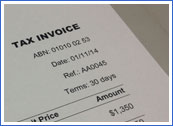
Corruption Matters - November 2014 | Issue 44
Five ways to better invoice payment control

The payment of supplier invoices is a perennial source of corruption risk and the ICAC has uncovered several instances in which poor processes have facilitated the payment of large sums of money via corruptly-submitted invoices. A new ICAC publication, Safeguarding public money: The importance of controlling invoice payments, outlines five strategies to improve invoice payment processes in your organisation.
In several ICAC investigations, the payment of invoices was the key means by which corrupt payments were facilitated. In Operation Charity, for example, over $600,000 worth of fraudulent invoices were paid and, similarly, in Operation Citrus, over $1.5 million worth of invoices were paid to a company owned by an agency officer. Invoices were also corruptly paid in operations Corsair, Jarek, Monto and Siren.
Because of the ICAC’s long history in exposing such corrupt conduct, and the near-ubiquity of the invoice payment function, the ICAC undertook a corruption prevention project to develop and encourage better practices to manage the associated risks.
This project identified five key strategies that can be used to control the payment of invoices. Each strategy is presented below, together with some examples of control mechanisms that can help implement it.
1. Develop motivated and capable accounts payable (AP) staff. Provide AP staff with easy access to delegations and sample signatures, or hardcode delegations into an electronic approval system, to ensure that invoices have been properly authorised. Provide suppliers with a central point of contact to prevent them from improperly pressuring individual AP staff.
2. Secure the vendor master file (VMF). Run internet, physical address or white pages checks on new vendors to detect whether they are likely to be non-genuine vendors. Segregate elements of inputting vendor details into the VMF, or monitor and review VMF changes, to ensure that vendor details are accurate.
3. Strengthen and protect payment processes. Embed preventative controls such as document-matching or cost-code checks into payment processes to prevent improper invoices from being processed. Carefully control system administrator access to avoid system controls from being improperly overridden.
4. Process invoices consistently. Reject poor quality invoices, and encourage suppliers to use web portals or electronic data interchange systems, to improve invoice quality. Subject rush payments to a controlled alternate process to prevent real or fake emergencies from facilitating corrupt payments.
5. Conduct informed review of expenditure. Have specific AP staff responsible for specific projects or regions, or make operational managers responsible for their staff’s transactions, to ensure that invoices are reviewed by knowledgeable officers. Analyse budget variations and run database reports on AP data to flag questionable transactions.
Each of these five strategies are discussed in greater detail in Safeguarding public money: The importance of controlling invoice payments, which is available from the ICAC website.